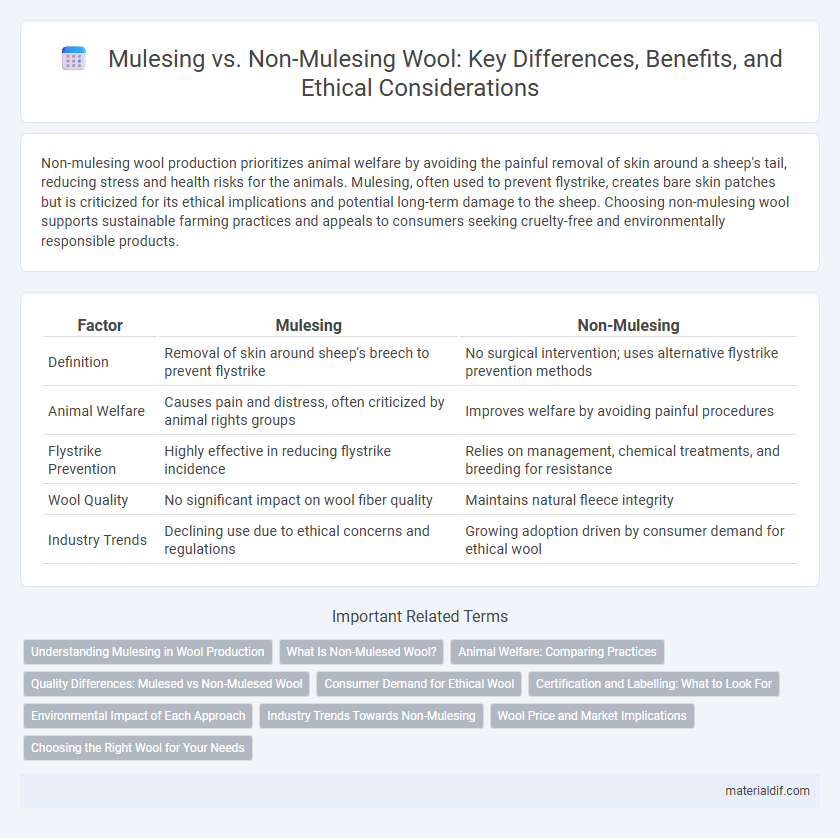Non-mulesing wool production prioritizes animal welfare by avoiding the painful removal of skin around a sheep's tail, reducing stress and health risks for the animals. Mulesing, often used to prevent flystrike, creates bare skin patches but is criticized for its ethical implications and potential long-term damage to the sheep. Choosing non-mulesing wool supports sustainable farming practices and appeals to consumers seeking cruelty-free and environmentally responsible products.
Table of Comparison
| Factor | Mulesing | Non-Mulesing |
|---|---|---|
| Definition | Removal of skin around sheep's breech to prevent flystrike | No surgical intervention; uses alternative flystrike prevention methods |
| Animal Welfare | Causes pain and distress, often criticized by animal rights groups | Improves welfare by avoiding painful procedures |
| Flystrike Prevention | Highly effective in reducing flystrike incidence | Relies on management, chemical treatments, and breeding for resistance |
| Wool Quality | No significant impact on wool fiber quality | Maintains natural fleece integrity |
| Industry Trends | Declining use due to ethical concerns and regulations | Growing adoption driven by consumer demand for ethical wool |
Understanding Mulesing in Wool Production
Mulesing is a controversial practice in wool production involving the removal of skin around the sheep's breech to prevent flystrike, predominantly used in Australia. Non-mulesed wool comes from sheep that have not undergone this surgical procedure, appealing to ethically-conscious consumers seeking animal welfare improvements. Advances in breeding and alternative flystrike prevention methods are driving increased demand for non-mulesed wool in sustainable and cruelty-free textile markets.
What Is Non-Mulesed Wool?
Non-mulesed wool comes from sheep that have not undergone the mulesing procedure, a surgical practice aimed at preventing flystrike by removing skin around the breech. This wool is considered more ethical and animal-friendly, appealing to consumers concerned with animal welfare and sustainable textile production. Non-mulesed wool maintains natural sheep protection while supporting cruelty-free farming practices and aligns with certifications like Responsible Wool Standard (RWS).
Animal Welfare: Comparing Practices
Mulesing involves the removal of skin from around a sheep's breech to prevent flystrike, but it raises significant animal welfare concerns due to the pain and stress caused. Non-mulesing practices prioritize alternative methods such as breeding sheep for flystrike resistance and improved farm management to enhance animal welfare without surgical intervention. Both practices impact wool quality, yet non-mulesing methods align better with ethical standards and consumer demand for cruelty-free wool products.
Quality Differences: Mulesed vs Non-Mulesed Wool
Non-mulesed wool generally maintains higher fiber integrity and softness due to the absence of stress and skin damage associated with mulesing procedures. Mulesed wool may exhibit variations in fiber uniformity and strength as a result of healing and potential scarring, which can impact overall textile quality. Despite these differences, advancements in animal welfare practices are increasing the availability of non-mulesed wool with consistent high-quality attributes suitable for premium fabrics.
Consumer Demand for Ethical Wool
Consumer demand for ethical wool significantly favors non-mulesing practices due to growing awareness of animal welfare issues. Brands sourcing non-mulesed wool are experiencing increased market preference as shoppers seek cruelty-free and sustainable products. This shift is driving the wool industry toward more humane standards and transparent supply chains.
Certification and Labelling: What to Look For
Look for certifications like Responsible Wool Standard (RWS) and ZQ Merino, which guarantee non-mulesed wool and prioritize animal welfare. Labels indicating "mulesing-free" or "non-mulesed" provide transparency and assure consumers of ethical sourcing practices. Verify certifications through trusted organizations to ensure compliance with strict animal welfare and sustainability criteria.
Environmental Impact of Each Approach
Mulesing, a common practice in wool production to prevent flystrike, has significant environmental implications due to increased resource use and potential soil degradation from infected sheep management. Non-mulesing wool production often relies on breeding flystrike-resistant sheep, reducing chemical treatments and minimizing ecological disturbances. This approach promotes sustainable land use and lowers the carbon footprint by enhancing animal welfare and reducing environmental contamination.
Industry Trends Towards Non-Mulesing
The wool industry is increasingly shifting towards non-mulesing practices due to growing consumer demand for ethically sourced wool and animal welfare concerns. Innovations in breeding programs and flystrike prevention techniques enable producers to maintain high-quality wool while eliminating the need for mulesing. Major wool brands and retailers now prioritize certification standards that exclude mulesed wool, driving global market trends towards more sustainable and humane production methods.
Wool Price and Market Implications
Non-mulesed wool often commands a premium price due to growing consumer demand for ethically produced textiles, influencing market trends towards sustainability. Wool from non-mulesed sheep is preferred by brands emphasizing animal welfare, which drives higher market value and niche export opportunities. Conversely, mulesed wool tends to be priced lower, reflecting concerns over animal rights that affect buyer preferences and international trade dynamics.
Choosing the Right Wool for Your Needs
Choosing the right wool involves understanding the differences between mulesing and non-mulesing practices, as mulesing is a method used to prevent flystrike in sheep by removing skin around the breech area. Non-mulesing wool comes from sheep bred and managed without this procedure, appealing to consumers seeking ethical and cruelty-free products. Consider certifications like Responsible Wool Standard (RWS) or ZQ Merino to ensure sustainable and humane wool production that aligns with your values and needs.
Mulesing vs Non-Mulesing Infographic

 materialdif.com
materialdif.com